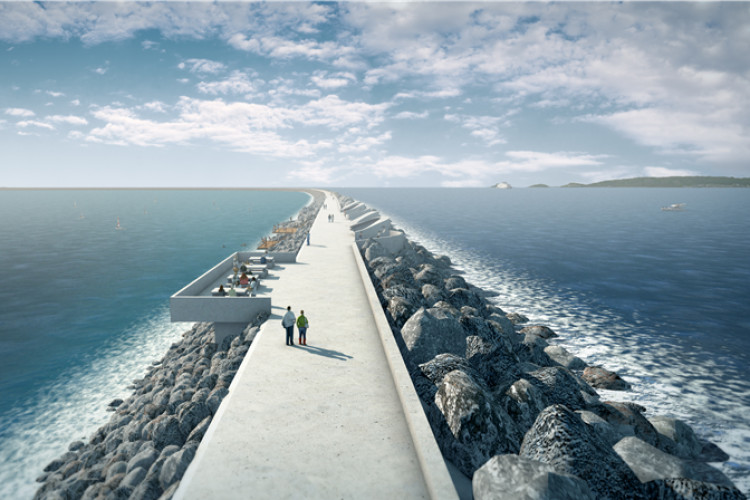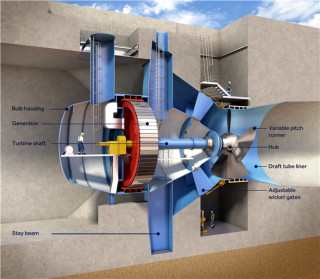Construction cost has been put at around £650m with overall capital investment of £850m. The aim is to start construction next year.
Tidal Lagoon Power Ltd (TLP) has submitted its application – all 5,000 pages of it – for a development consent order (DCO) under the Planning Act 2008.
Swansea Bay Tidal Lagoon would be the largest tidal power plant in the world. As a project of national significance, the application will now be reviewed by the Planning Inspectorate before public examination, and then determination by the secretary of state for energy.
The project involves the construction of a 9.5km-long sea wall around Swansea Bay to create a lagoon in the Severn Estuary. Turbines would harness the movement of the tide to capture enough renewable energy to power more than 120,000 homes for 120 years, the developers say.
The lagoon would create a new waterfront for Swansea, with a 3,500m2 visitor, operations and maintenance building, pictured below, designed by Juice Architects.
The masterplan, design coordination and public realm design for the project, by London 2012 Olympic Park designer LDA Design, creates a ‘Maritime Park’ between Swansea Bay’s beach to the west and Crymlyn Burrows natural dune system to the east.
If given the go-ahead, construction of the Swansea Bay lagoon could begin in the first half of 2015, with first power being generated in 2018.

TLP has ambitions to build four more tidal lagoon power plants by 2023 to meet 10% of the UK’s domestic electricity needs.
CEO Mark Shorrock said that the submission of the application marks a turning point in the development of the UK’s tidal resource.
“Until now, tidal energy has been heavily promoted by governments and environmentalists as an intuitive source of clean and reliable energy for our island nation, but the business response has focused on relatively small-scale tidal stream devices. The UK has the second highest tidal range in the world and today we are submitting an application for a development that will prove that this resource can be harnessed in a way that makes economic, environmental and social sense. Tidal lagoons offer renewable energy at nuclear scale and thus the investment of hundreds of millions of pounds in UK industries and coastal communities.
“Our intention is to supply 10% of the UK’s domestic electricity by building at least five full-scale tidal lagoons in UK waters by 2023, before the UK sees any generation from new nuclear. Economies of scale bring immediate advantage. A second lagoon will require a lower level of support than offshore wind, for a renewable power supply that is both long-lived and certain. A third lagoon will be competitive with the support received by new nuclear, but comes without the decommissioning costs and safety concerns.”
The Cheltenham-based company has spent three years and many millions in developing its proof-of concept project, alongside a consortium that includes Atkins, Costain, GE, Alstom, Andritz and Voith. It has the commitment of Australian bank Macquarie to lead the capital financing of the project itself.
Atkins CEO for UK and Europe David Tonkin said: “Energy security is a pressing global challenge and we need to find increasingly smart solutions to meet our current and future needs. The tidal lagoon concept represents a bold new addition to the energy mix. It is a great example of how innovative engineering could be used to harness our natural resources and provide clean, sustainable and predictable power for thousands of homes. Through our long involvement with major infrastructure projects around the world we know the benefits they can deliver in terms of improving people’s lives. We see the same potential in this case, as well as a great opportunity for Britain to export the technological know-how to other countries in the longer term.”
Got a story? Email news@theconstructionindex.co.uk





